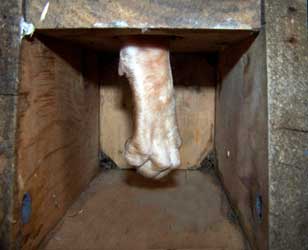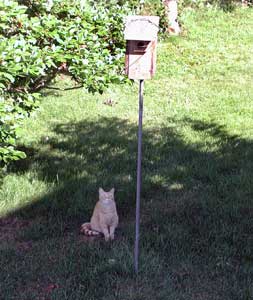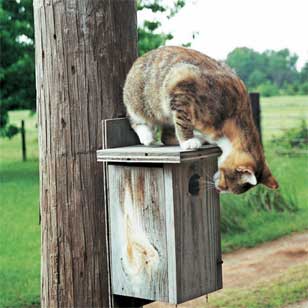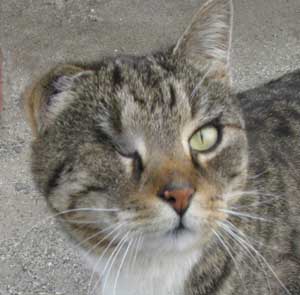Quick Tips: We all know cats kill birds. To prevent cats from preying on eggs/nestlings, keep cats indoors, use a hanging nestbox, a predator guard, mount boxes 6 ft.+ off the ground, use a box with a large overhanging roof.





Cats are natural born hunters. Bluebirds are very vulnerable to cat attacks because adults hunt on the ground, and sometimes new fledglings cannot fly well.
No one knows exactly how many birds are killed by cats each year, but estimates run in the hundreds of millions. One Michigan survey indicated on average a domestic cat killed between 0.7 and 1.4 birds per week. (Tiny cameras mounted on cat collars showed some premier hunters killed 10-12 birds in one night!)
Next to habitat loss and fragmentation, cats are considered the most serious threat to songbird populations worldwide. In a few months, one feral cat can kill all the bluebirds you helped fledge in a year. Since some areas only have one or two pairs of nesting bluebirds, the loss of even one bird can have a real impact on local populations.
Some wildlife rehabbers find that #1 cause of admissions to their facilities is domestic and feral cat attacks. Well-fed cats will still kill birds and animals. A cat with a bell on its collar can stalk silently so the bell does not ring, and even if it did, a bird does not recognize the connection between a bell and a predator. A declawed cat can still climb, and one killed more animals than any other cat in a study in Kansas. A feral (wild, with no owner) cat that is neutered and released will continue to hunt and kill.
Cats can easily jump on top of a nestbox that is at least 5 feet high. Some can jump as high as 6 feet, and Keith Kridler heard a report of one that could jump 7 feet (especially off of a hard surface). A cat can use its curved claws to reach into the bird house and hook fledglings and nesting adults. An agile cat can leap into the air and catch a Tree Swallow dive bombing to protect its’ nest.
 While birds that nest or feed on the ground are at greatest risk, fledglings that can not fly well are also a target. Possible signs of a cat attack on a nestbox include missing nestlings with the nest still intact or messed up. Grass below the nestbox may be trampled. There are usually some feathers around. Dead adults (missing or matted feathers or wounds) may also be found. Eggs are usually left, but may be broken.
While birds that nest or feed on the ground are at greatest risk, fledglings that can not fly well are also a target. Possible signs of a cat attack on a nestbox include missing nestlings with the nest still intact or messed up. Grass below the nestbox may be trampled. There are usually some feathers around. Dead adults (missing or matted feathers or wounds) may also be found. Eggs are usually left, but may be broken.
Any bird handled by a cat should be brought to a wildlife rehabilitator immediately. Unfortunately, because many cats have nasty bacteria and viruses in their mouths and tend to bat prey around (causing severe internal injuries), about 80% of their victims die even if they receive immediate treatment. But it is still worth a try.
Many people believe that a love of wildlife and cats outdoors are incompatible. It is not possible to monitor a nestbox 24/7. If you are unwilling to protect bluebirds from being attacked by cats, it is probably better to remove nestboxes rather than invite birds to nest in an unsafe situation.
INDOOR V. OUTDOOR CATS: Free-roaming outdoor cats typically live less than five years, while indoor cats often live to be 17 or older. Indoor cats can be happy, and are definitely healthier. Outdoor cats are exposed to many hazards, including cars, poisoning, animal attacks (coyotes and fishers eat cats), human abuse, traps, contagious diseases of which many are fatal (feline leukemia, feline distemper, infectious peritonitis, Immunodeficiency Virus, upper respiratory infections, rabies, plague, cat scratch disease, toxoplasmosis), and parasites. Vet bills associated with tapeworm, ringworm, roundworm, or hookworm and flea infestations, and abscesses can be substantial. Outdoor cats may also transport ticks into the home, increasing the likelihood that family members will contract tick-borne illnesses like Lyme Disease.
Another threat is Toxoplasma. Although it causes no symptoms in many people, it can cause serious brain damage in people with weak immune systems. Once infected, you are infected for life. Cats play a major role in transmitting this parasite. According to the New York Times (06/20/06), ONE infected cat can shed 100 million egglike cysts called oocysts in its droppings. The oocysts can survive in the soil for over a year and contaminate wildlife and drinking water. Dr. Milton M. McAllister, a parasitologist at the University of Illinois at Chicago, says “It’s perfectly safe to keep a cat. Just keep it inside.”
Despite the downsides, about 65% of cat owners let their cats roam free. Thanks for former cat owners, there are also millions of homeless (feral) cats.
SOLUTIONS:
NESTBOXES: (some of which will also help protect nestboxes from raccoon predation)
- Use a hanging nestbox (e.g., hanging from a branch on a tree.) See plan on NestboxBuilder for 2-Hole Mansion designed by Linda Violett
- Use a predator guard, which will also deter raccoons:
- Use predator guards on the nestbox pole, such as an inverted cone, a wobbling PVC baffle, or a stovepipe guard. Ideally, mount the baffle high enough so a cat can’t jump up and sit on top of it.
- Use a Noel Predator Guard on the nestbox (a sort of wire cage around the hole – only put it up AFTER eggs have been laid – see plans to make your own.)
- The “Bird Guardian” plastic tube sold commercially is NOT recommended, as Dorene Scriven indicates bluebirds do not like it.
- Use a (Don Hutchings) PVC hole guard and restrictor combination, made with a flat-topped 4″ PVC sewer and drainpipe cap and a 6″ length of 4″-diameter PVC pipe. The cap is drilled with two holes, one for bluebirds and one for chickadees. Either hole can be placed over the nestbox entrance hole and the cap screwed to the front of the nestbox. The 6″ length of pipe fits into the cap and is held by three short screws that fit through holes drilled into the collar of the cap. The cap and pipe could be glued together, but a screwdriver with an extension would then be needed to attach the device to the nestbox.
- A large overhanging roof (2-5″) on a nestbox will help deter cats from reaching into the box to remove eggs, nestlings and adults. A sharply slanted roof may make it less comfortable for cats to perch on top of a box. Linda Violett has no problems with cats and her two-holed mansions. See Plan.
- Either mount the box on smooth metal pipe (electrical conduit) with the floor at least 6 feet off the ground, or use a telescoping pole, with the box 8-10′ above the ground. Bluebirds will readily nest at this height. The box can be raised to this height even if bluebirds have nestlings or eggs in a box – they should quickly accept the change.
- To make a telescoping pole, use a shorter length of 3/4″ conduit, and then a telescoping length of 1/2″ conduit onto which the box is mounted. Cut the top end of the bottom part (the “sleeve”) at a 45-degree angle so you can drill it for screw holes. (See photo on pages 110 and 111 of The Bluebird Monitor’s Guide). Dan Hanan recommends drilling a hole for a nail in the upper piece of conduit. That way if the upper end of the bottom piece of EMT is notched or cut at an angle, the nail will align itself with the notch and will keep the entrance hole orientation the same.
- If you need a stronger pole, use a 1″ + 3/4″ conduit combination.
- You can also mount the conduit over rebar and use a conduit connector (with a longer screw on the bottom) to raise and lower the box.
- To make a telescoping pole, use a shorter length of 3/4″ conduit, and then a telescoping length of 1/2″ conduit onto which the box is mounted. Cut the top end of the bottom part (the “sleeve”) at a 45-degree angle so you can drill it for screw holes. (See photo on pages 110 and 111 of The Bluebird Monitor’s Guide). Dan Hanan recommends drilling a hole for a nail in the upper piece of conduit. That way if the upper end of the bottom piece of EMT is notched or cut at an angle, the nail will align itself with the notch and will keep the entrance hole orientation the same.
- Thoroughly grease (and re-grease when needed) a metal mounting pole. You can also add hot pepper sauce to the grease (an additional deterrent as the cat will lick it off its paws.)
- Do not mount nestboxes on a wooden post or tree, or near a fence/trellis/tree that a cat can climb.
- If you can’t move a box far enough away from a fence, try this: lay barbed wire along the top of the fence for about 8 feet in either direction of the house and loosely secure it so it would bounce against any animal that climbed along the fence rail. (Thanks for the tip Erica.)
- Mount nestboxes securely (e.g., with bolts) so a cat can not pull them down. Fasten boxes closed with screws.
- Methyl nonyl ketone is used in more than 30 registered dog and cat repellants, primarily to keep the animals away from areas where defecation or urination is a problem. It might also work around nestboxes.
CATS:
- See How to Make Your Outdoor Cat a Happy Indoor Cat. Cat owners can keep their cats indoors, on a leash, in a cat stroller, or in outdoor enclosures or cat runs.
- C&D Pet Products sells a Cat Enclosure Kit, which is a 6′ X 6′ X 6′ play area.
- Catfencin.com sells cat fences, and other sites offer a variety of pet enclosures.
- It is convenient to connect it to a swinging pet door so the cat can let itself in and out. The enclosure will prevent other outdoor critters from gaining access through the pet door. Before you go out and purchase a pet door, decide whether you really want your cat going outdoors at their own will.
- A new product called the CatBib stopped 81% of cats from catching birds in a study by Murdoch University.
- Another product is a decorative collar called BirdsbeSafe that is supposed to prevent bird predation.
- To train a cat to be on a leash and harness, start by leaving the harness by the food dish to the cat associates it with being fed, and practice inside first. Don’t expect the cat to get very far.
- Confine cats during nesting season.
- On a weekly basis, trim front claws of a pet cat that can not be confined.
- Do not feed feral cats. Strays will often reproduce where there is a source of food, thus creating large feral cat colonies.
- Call Animal Control if it illegal to have cats outdoors. The owner will have to pay to retrieve the cat. Note that many Animal Control centers euthanize unclaimed cats after 72 hours.
- Trapping: Try to trap feral cats using a Hav-a-Hart trap (double door 36″ x 11″x 11″) baited with cat food, catnip (some cats can’t resist, but other animals won’t be attracted), tuna, sardines or anchovies (put food inside pantyhose and tie it to the trap so they can’t stand outside and pull the food out OR put it underneath the trap), and bring them to a shelter or animal control agency. (You may be able to borrow or rent a trap from animal control.) Unlike a domestic cat, a feral cat will generally snarl and try to attack when trapped. Note about contact with feral cats: the Northeast District Department of Health in CT recommends avoiding any contact with stray animals, including cats. This includes touching, holding, transporting, feeding or caring for a stray. These animals can carry rabies or transmit other diseases and should only be handled by an animal control officer.
- One person suggested that if it is a domestic cat and you know the owner, return it with a note that says something to the effect of “If I see this cat in my yard again, it will have a nice home somewhere far away from my yard, in the care of someone more responsible.”
- One trail monitor prepared a small pamphlet about the problem and distributed it to all neighbors. He also informed them in the pamphlet that he was going to begin and maintain a very aggressive cat trapping program and that 100% of the trapped cats would be turned over to a local coyote rehabber. Apparently many of the outdoor cats became indoor cats shortly thereafter.
- Some humane societies or animal shelters will accept trapped cats. Others will not, due to lack of homes, difficulty placing adults cats, concerns about behavior, etc. Be aware they may charge a fee, or be located some distance away.
- Some local Animal Control offices accept cats.
- Run a “hot wire” from an electric fence charger about 12″ off the ground around your property, and turn it on at night.
- Get a soda can and fill it with pennies, and shake it loudly when a cat comes around.
- Wooden pegs installed on the inside front of the box probably do NOT deter cats or raccoons.
- Some people sting a feral/free roaming cat in the hindquarters with a low-powered child-size BB gun (not pumped enough to penetrate skin) or paint ball gun (Note: may cause bruise depending on power and distance).
- In some areas it is legal to destroy any cat found hunting any protected bird. Of course this is a very controversial step.
Other possible solutions (effectiveness unknown):
- Place mothballs around the base of the nestbox.
- Put broken hazelnut shells (available from some landscaping companies) around base of nestbox. (Hard to find? Expensive?)
- Vinegar: Fill some jars with it, put the lids on, and poke some holes in the lids so the smell gets out. (Works for raccoons)
- Spritz coyote urine around the base of the nestbox (reportedly moderately effective against raccoons. Powdered urine must be refreshed after a heavy rain.)
- Crinkle up chicken wire a little (cats supposedly do not like to walk on it) and place it around base of nestbox.
- Set mouse traps in a circle around the base of the trap.
- Place a “dowel fence” around the edges of the nestbox roof.
- Use a motion activated burglar alarm or water sprayer/sprinkler activated by animal movement like CatStop.
- Nestboxes with two entrance holes on either side of the box which might allow adults to escape an attack.
NOTE: Stray vs. Feral: A stray cat is abandoned or lost. It can be rehabilitated to live again in a safe home environment. You are doing it a favor by catching it (humanely trapping it) and then turning it over to your local no kill rescue group to find it a home. A feral cat has been born in the wild and has little hope of ever adapting to live in a home environment. While they can get used to being around humans, adult ferals will always be “wild”. They should be trapped and neutered and given to a friend who needs a guard for a barn. Otherwise, they go on to produce other feral cats ad infinitum. Feral kittens can be trapped and imprinted to people if they are caught at a young enough age – under 12 weeks. (Thanks to Furryrocious for this summary)
For more information:
- Predator and Problem ID and Solutions
- Drawings of Don Hutchings Predator Guard, The Bluebird Box
- Is it okay to mount boxes on trees?
- American Bird Conservancy: Cats Indoors! The Campaign for Safer Birds and Cats
- Keep Your Cats Indoors, National Wildlife Federation
- How to Make Your Outdoor Cat a Happy Indoor Cat, American Bird Conservancy
- Hanging nestboxes – instructions from NestboxBuilder
- David Gwin’s hanging nestbox set up
- Photos of dead chickadee nestlings – mother probably killed by cat
- Emergency Baby Bird Care/Care for Injured Birds
The most petted, pampered tabby is still a bird hunter.
– Joseph H. Dodson, Your Bird Friends and How to Win Them, 1928
